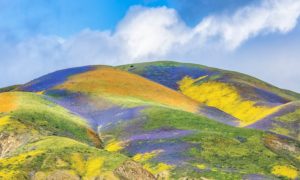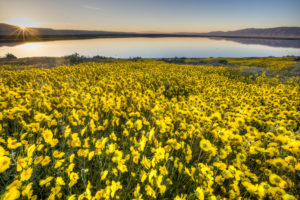
The Temblor Mountains were in full wildflower majesty during the 2017 superbloom. Photo by Ronald L. Williams
Click here to submit your letter!
Today, the Department of the Interior published a notice in the Federal Register announcing a 60-day comment period on its review of 27 national monuments, including the Carrizo Plain National Monument in San Luis Obispo County.
President Trump ordered the review in an executive order signed two weeks ago, directing the Secretary of the Interior to recommend whether to shrink the size of national monuments of more than 100,000 acre designated since 1996, or to eliminate them entirely.
Also today, Los Padres ForestWatch – a local conservation group that works to protect the Carrizo Plain National Monument and the adjacent Los Padres National Forest – launched a website to make it easy for the public to submit comments. Those who want to learn more about the Carrizo Plain, the possible cancellation of its protected status, and how to submit public comments can visit savethecarrizo.org. The website features an interactive map, stunning photography of the area’s landscapes and wildlife, and an easy-to-use form and talking points that concerned residents can use to submit a letter to Interior Secretary Zinke with the click of a button.

Soda Lake is one of the features that makes the Carrizo Plain National Monument so unique. Photo by Bob Wick
This review is a thinly-veiled attack on America’s national monuments and public lands, and it hits home right here in our own backyard. We encourage everyone to write letters, highlighting the benefits that these iconic landscapes provide to our local communities and urging this Administration to protect our national monuments.
ForestWatch has pledged to gather 10,000 letters to submit to the Department of the Interior during the comment period, showing widespread support for the Carrizo Plain National Monument.
Today’s Federal Register notice also announces a shorter 15-day comment period for the Bears Ears National Monument, a 1.3-million-acre reserve in Utah established by President Obama following a thorough public process.
President Trump’s order directs Interior Secretary Zinke to report back to him within 120 days, or mid-August. Conservation groups from across the country are uniting to preserve our nation’s historical, cultural, and natural heritage.
Background Information
The Antiquities Act was signed by President Teddy Roosevelt in 1906 to safeguard and preserve U.S. public lands and cultural and historical sites for all Americans to enjoy. Sixteen presidents – eight Republicans and eight Democrats – have used this authority to protect places from the Grand Canyon to Acadia. Today, 129 national monuments are found across 31 states, representing an important component of our country’s heritage.
The Carrizo Plain National Monument was established by President William Jefferson Clinton on January 17, 2001. The proclamation establishing the monument states:
Full of natural splendor and rich in human history, the majestic grasslands and stark ridges in the Carrizo Plain National Monument contain exceptional objects of scientific and historic interest. Since the mid-1800s, large portions of the grasslands that once spanned the entire four hundred mile expanse of California’s nearby San Joaquin Valley and other valleys in the vicinity have been eliminated by extensive land conversion to agricultural, industrial, and urban land uses. The Carrizo Plain National Monument, which is dramatically bisected by the San Andreas Fault zone, is the largest undeveloped remnant of this ecosystem, providing crucial habitat for the long-term conservation of the many endemic plant and animal species that still inhabit the area.

With the Caliente and Temblor Mountains on either side of the Carrizo Plain, breathtaking views are everywhere. Photo by Bob Wick
The Carrizo Plain’s national monument status protects the area from new oil leases while retaining existing drilling rights, and also prohibits target shooting and off-road vehicles. The mineral rights underneath the Carrizo Plain are privately owned, and one of the largest oil fields in the nation is located east of the monument. If the national monument is shrunk or eliminated, it could leave the Carrizo Plain vulnerable to development and threaten the unique scientific and historical features that make this area unique.
The Carrizo Plain National Monument was subject to an extensive public process. Prior to its designation as a national monument, the Carrizo Plain Natural Area was recognized by the U.S. Bureau of Land Management in the 1980s. A Resource Advisory Committee was established in 1999 consisting of representatives from federal and state land management agencies, conservation organizations, livestock grazing and oil drilling interests, and other stakeholders. The management plan for the monument – completed in 2010 – was subject to an extensive public comment period that included several hearings and the submission of more than 15,000 letters supporting the protection of the Carrizo Plain National Monument.







Comments are closed.